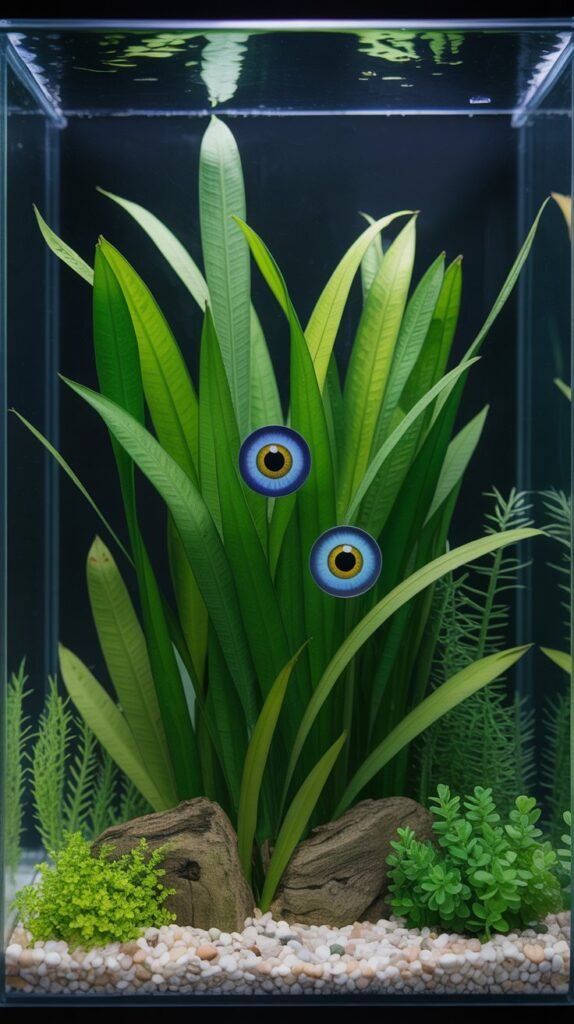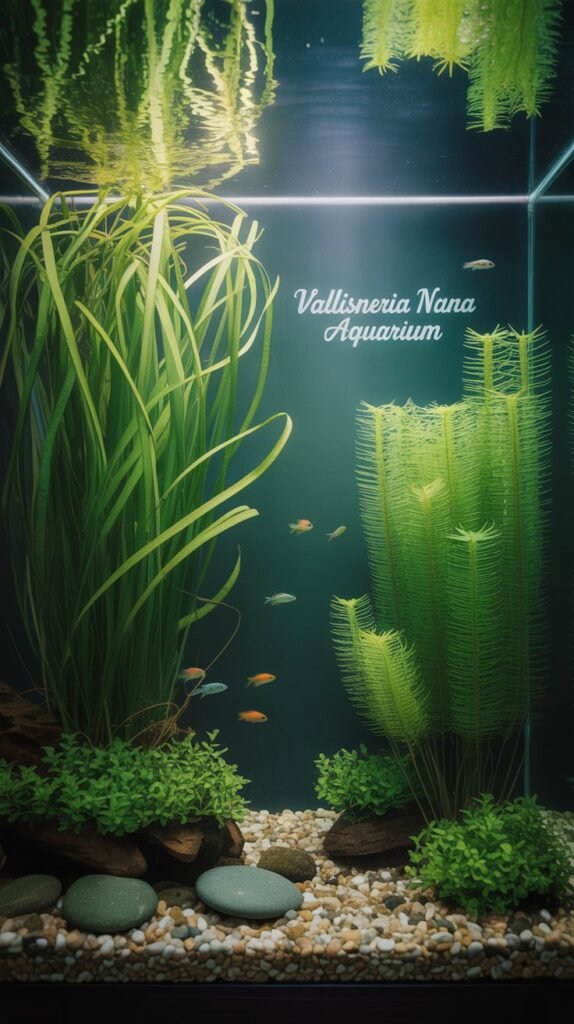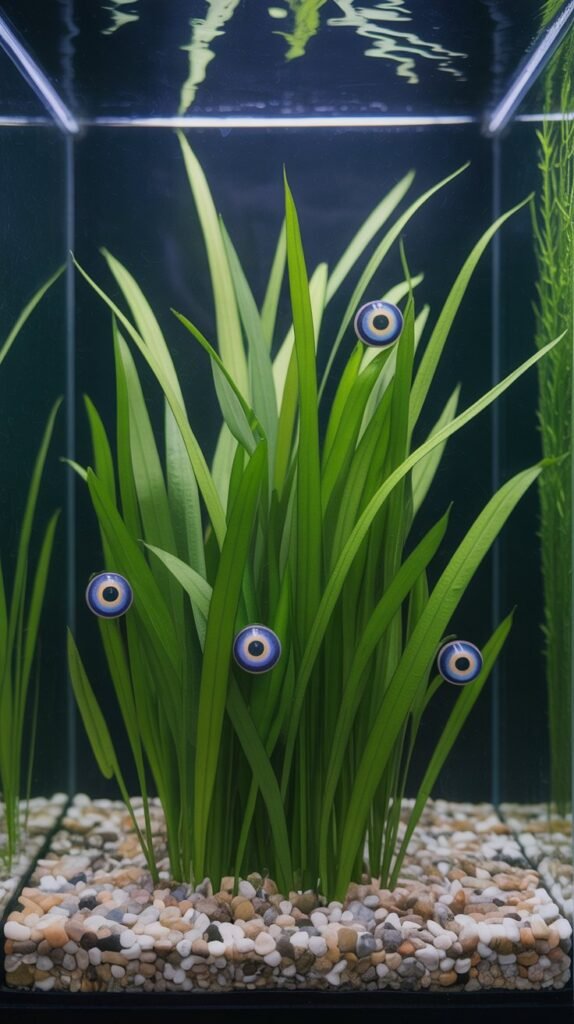Aquarium plants are essential in creating a thriving aquatic ecosystem, providing oxygen, reducing waste, and offering a natural environment for fish and invertebrates. One plant that has earned a special place among aquarists is Vallisneria nana, a graceful and hardy background plant known for its slender leaves and adaptability.
Commonly referred to as Thin Vallisneria or Narrow-leaved Vallisneria, this species is especially popular in aquascaping because of its tall, ribbon-like leaves that sway beautifully in the current. Whether you’re a beginner looking for an easy plant or an advanced aquascaper aiming for a natural background effect, Vallisneria nana in aquariums is a fantastic choice.
In this guide, we’ll dive deep into everything you need to know about growing and caring for Vallisneria nana—from its origins and benefits to planting methods, tank requirements, propagation, and troubleshooting common issues.
What is Vallisneria nana?
Vallisneria nana is a freshwater aquatic plant belonging to the Hydrocharitaceae family. It is native to Northern Australia, particularly around slow-moving rivers, lagoons, and streams, where it grows in dense colonies.
Key Characteristics:
- Appearance: Long, narrow, grass-like leaves that range between 12–24 inches in height.
- Leaf structure: Dark green, ribbon-shaped leaves, usually 3–8 mm wide, forming dense underwater meadows.
- Growth style: Rooted rosette plant that spreads through runners.
- Tank role: Ideal as a background plant in aquariums, creating a lush “underwater forest” effect.
Unlike its relatives (like Vallisneria spiralis), Vallisneria nana stays slimmer and less bushy, giving it a distinct “minimalist” aesthetic in aquascaping.
Benefits of Vallisneria nana in Aquariums

Adding Vallisneria nana to your aquarium offers multiple advantages beyond aesthetics.
1. Oxygenation and Water Quality
Like other aquatic plants, Vallisneria nana absorbs CO₂ and releases oxygen through photosynthesis, improving water conditions for fish and beneficial bacteria.
2. Nutrient Absorption
It consumes excess nutrients such as nitrates and phosphates, helping reduce algae growth and keeping water chemistry stable.
3. Natural Shelter
Its long, thin leaves provide shelter and hiding spots for small fish, fry, and shrimp. Schooling fish like rasboras and tetras feel more secure in tanks with dense Vallisneria growth.
4. Aesthetic Appeal
The vertical, grass-like appearance sways gently in the current, adding elegance and movement to aquascapes. It also contrasts beautifully with low-growing carpet plants and mid-ground species.
5. Hardy and Beginner-Friendly
Vallisneria nana is adaptable to a wide range of conditions, making it one of the best background plants for beginners.
6. Compatibility
Safe for most community fish and invertebrates, unlike more delicate species that might be eaten or uprooted.
Ideal Tank Conditions for Vallisneria nana
Although Vallisneria nana is hardy and adaptable, providing the right environment ensures healthier and faster growth.
Water Parameters
- Temperature: 68–82°F (20–28°C)
- pH: 6.0–8.0
- Hardness: Soft to moderately hard water
Lighting
- Moderate lighting is sufficient.
- Stronger lighting encourages faster growth and denser leaf production.
- Low light is tolerated, but leaves may grow taller and thinner.
Substrate
- Vallisneria nana is a root-feeding plant.
- Best grown in nutrient-rich substrate (aquarium soil, clay-based substrates).
- In sand or gravel, supplement with root tabs for optimal growth.
Tank Size
- Due to its tall leaves (up to 24 inches), Vallisneria nana is best suited for medium to large aquariums (20 gallons or larger).
- In small tanks, it may overwhelm the aquascape.
CO₂ and Fertilizers
- CO₂ injection is optional, not required.
- Root tabs and occasional liquid fertilizers support long-term growth, especially in lean substrates.
Planting Vallisneria nana

Step 1: Preparing the Plant
- Rinse the plant gently to remove debris.
- Trim any damaged or melting leaves.
Step 2: Planting Technique
- Plant individual rosettes into the substrate using aquascaping tweezers.
- Ensure roots are buried, but the crown (where leaves meet roots) stays above the substrate to prevent rot.
Step 3: Spacing
- Space plants 2–3 inches apart. This allows room for runners while encouraging a natural meadow effect.
Growth and Propagation
Growth Pattern
- Vallisneria nana grows tall leaves from a central rosette.
- Under good conditions, new leaves continuously sprout, creating dense clumps.
Propagation
- This plant spreads through runners—horizontal stems that send out new plantlets.
- Once established, runners quickly spread across the aquarium, forming thick underwater lawns.
Maintenance
- Trim excess runners if the plant spreads too aggressively.
- Remove yellow or damaged leaves regularly.
- Avoid cutting leaves mid-way; instead, trim at the base for healthier regrowth.
Vallisneria nana in Aquascaping
Vallisneria nana is highly valued in aquascaping due to its unique shape and growth style.
Design Roles
- Background Plant – Perfect for creating a tall, grassy backdrop.
- Natural Riverbank Effect – Its vertical leaves mimic river grasses found in nature aquariums.
- Contrast Element – Works beautifully alongside shorter carpeting plants (like Dwarf Sagittaria or Monte Carlo).
- Fish Habitat – Schooling fish like neon tetras and rasboras thrive in tanks with Vallisneria nana, as it simulates natural habitats.
Aquascaping Styles
- Nature Aquariums: Blends seamlessly with driftwood, rocks, and carpeting plants.
- Biotope Tanks: Ideal for simulating natural Australian or Asian freshwater environments.
- Minimalist Designs: Its slender leaves create open, airy aquascapes.
Tank Mates for Vallisneria nana
Compatible Tank Mates:
- Small schooling fish: tetras, rasboras, danios
- Livebearers: guppies, mollies, swordtails
- Bottom dwellers: corydoras, kuhli loaches, otocinclus
- Shrimp and snails: cherry shrimp, amano shrimp, nerite snails
Tank Mates to Avoid:
- Goldfish – They may uproot and eat Vallisneria.
- Large cichlids (oscars, jack dempseys) – Known for digging and damaging plants.
- Plant-eating fish like silver dollars.
Common Problems with Vallisneria nana

Despite its hardiness, Vallisneria nana can face certain issues if not properly cared for.
1. Melting Leaves
- Common after initial planting due to environmental shock.
- Solution: Trim melted leaves and wait—new growth usually appears soon.
2. Yellow or Transparent Leaves
- Indicates nutrient deficiencies (especially iron or potassium).
- Solution: Use root tabs or liquid fertilizers.
3. Slow Growth
- Caused by insufficient lighting or lack of nutrients.
- Solution: Increase light intensity or supplement nutrients.
4. Excessive Spreading
- Runners may overtake the aquarium.
- Solution: Regularly trim runners and thin out colonies.
5. Algae Growth
- Long leaves can collect algae in high-light tanks.
- Solution: Maintain water balance, add algae eaters, and prune affected leaves.
Vallisneria nana vs. Other Vallisneria Species
| Feature | Vallisneria nana | Vallisneria spiralis | Vallisneria americana |
|---|---|---|---|
| Leaf Width | Very narrow (3–8 mm) | Medium width (10–15 mm) | Broad (20+ mm) |
| Leaf Height | 12–24 inches | 12–24 inches | Up to 36 inches |
| Appearance | Slender, grassy | Ribbon-like | Wide, ribbon leaves |
| Growth Speed | Moderate-Fast | Fast | Moderate |
| Aquascaping Role | Background/river effect | Background wall | Large tanks, background |
Vallisneria nana stands out for its thin, elegant leaves, making it the best choice for minimalist or nature-style aquascapes.
Best Aquarium Setups for Vallisneria nana
- Community Aquarium
- Vallisneria nana provides cover for small fish and fry, while maintaining water quality.
- Nature Aquarium
- Combine with driftwood, stones, and carpeting plants for a natural look.
- Biotope Aquarium
- Perfect for recreating Australian freshwater riverbanks with native fish.
- Shrimp Tank
- Provides vertical shelter and surfaces for biofilm growth.
Conclusion
Vallisneria nana is one of the most elegant and easy-to-care-for aquarium plants available. Its slender, ribbon-like leaves create a graceful background effect while also serving practical functions like oxygenation, nutrient absorption, and providing shelter for fish.
Ideal for both beginners and advanced aquascapers, Vallisneria nana is hardy, fast-growing, and adaptable to a wide range of conditions. Whether you’re designing a lush nature-style aquascape or simply looking for a hardy plant to improve your aquarium’s ecosystem, Vallisneria nana is an excellent choice.
FAQs About Vallisneria nana Aquarium
1. Is Vallisneria nana easy to grow?
Yes, it is one of the easiest aquarium plants, suitable for beginners.
2. Does Vallisneria nana need CO₂?
No, but CO₂ injection promotes faster and denser growth.
3. How tall does Vallisneria nana grow?
It typically reaches 12–24 inches, depending on tank conditions.
4. Can it grow in low light?
Yes, but it may grow taller and thinner. Moderate lighting produces better results.
5. Does Vallisneria nana carpet?
No, it does not carpet. Instead, it spreads with runners to form dense background meadows.
6. Can Vallisneria nana be grown in sand?
Yes, but it will need root tabs for nutrients.
7. Why is my Vallisneria nana turning yellow?
This usually indicates nutrient deficiencies (iron, potassium, or nitrogen).
8. Is Vallisneria nana safe for shrimp?
Yes, it provides excellent cover and surfaces for shrimp to graze on.
9. Will goldfish eat Vallisneria nana?
Yes, goldfish may eat or uproot it, so it’s not recommended for goldfish tanks.
10. How does Vallisneria nana propagate?
It spreads through runners, which develop into new plants.

